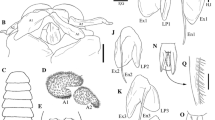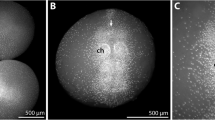Abstract
Developmental modes in pycnogonids are variable, even between congeneric species. Most of our previous knowledge of pycnogonid life history stages is based on morphological descriptions of the larval and those postlarval instars still retained on male ovigers, whereas the free-living instars are largely unknown. In this paper, a combination of morphological and molecular tools is used in order to link those postlarval instars retained on male ovigers to free-living specimens representing putatively later stages in the postembryonic development of a sea spider species. Male specimens of Nymphon australe carrying postembryonic instars were collected from localities off the South Shetland Islands, the Weddell Sea, the Drake Passage, the Bransfield Strait, and the Ross Sea. Three subsequent free-living instars were collected from Drake Passage. Nymphon australe hatch as a postlarval instar with two-articled palps and limb buds of the two first-walking legs. Postlarval instars 1 and 2 (both carried on the ovigers of males), postlarval instars 3 and 4, and a juvenile (all three free living) are all described and illustrated. A molecular phylogenetic based on the cox1 gene links all free-living stages to N. australe populations from the Antarctic Peninsula. The postlarval development of N. australe is discussed here and compared with those known from other pycnogonid species with similar development pathways.







Similar content being viewed by others
References
Alexeeva N, Bogomolova E, Tamberg Y, Shunatova N (2017) Oligomeric larvae of the pycnogonids revisited. J Morphol. https://doi.org/10.1002/jmor.20713
Alexeeva N, Tamberg Y, Shunatova N (2018) Postembryonic development of pycnogonids: a deeper look inside. Arthropod Struct Dev 47:299–317
Arabi J, Cruaud C, Couloux A, Hassanin A (2010) Studying sources of incongruence in arthropod molecular phylogenies: sea spiders (Pycnogonida) as a case study. C R Biol 333:438–453
Arango CP (2002) Morphological phylogenetics of the sea spiders (Arthropoda: Pycnogonida). Org Divers Evol 2:107–125
Arango CP, Wheeler WC (2007) Phylogeny of the sea spiders (Arthropoda, Pycnogonida) based on direct optimization of six loci and morphology. Cladistics 23:1–39
Arango CP, Soler-Membrives A, Miller KJ (2011) Genetic differentiation in the circum-Antarctic sea spider Nymphon australe (Pycnogonida; Nymphonidae). Deep Sea Res II 58:212–219
Arnaud F, Bamber R (1987) The biology of Pycnogonida. Adv Mar Biol 24:1–96
Bain BA (1992) Pycnogonid higher classification and a revision of the genus Austropallene (Family Callipallenidae). Ph.D. Diss., City University of New York, New York
Bain BA (2003a) Larval types and a summary of postembryonic development within the pycnogonids. Invertebr Reprod Dev 43:193–222
Bain BA (2003b) Postembryonic development in the pycnogonid Austropallene cornigera (Family Callipallenidae). Invertebr Reprod Dev 43:181–192
Bamber RN (2007) A holistic re-interpretation of the phylogeny of the Pycnogonida Latreille, 1810 (Arthropoda). Zootaxa 1668:295–312
Bamber RN, El Nagar A (eds) (2018) PycnoBase: world pycnogonida database. https://www.marinespecies.org/pycnobase/. Accessed 7 Sept 2018
Behrens W (1984) Larvenentwicklung und Metamorphose von Pycnogonum litorale (Chelicerata, Pantopoda). Zoomorphology 104:266–279
Bogomolova EV (2007) Larvae of three sea spider species of the Genus Nymphon (Arthropoda: Pycnogonida) from the White Sea. Russ J Mar Biol 33:145–160
Bogomolova EV (2010) Nymphon macronyx (Arthropoda, Pycnogonida), another pycnogonid species with lecytotrophic protonymphon development. Zool Zh 89:528–544
Bogomolova EV, Malakhov VV (2003) Larvae of sea spiders (Arthropoda, Pycnogonida) of the White Sea. Entomol Rev 82:213–227
Bogomolova EV, Malakhov VV (2004) Fine morphology of sea spider larvae (Arthropoda, Pycnogonida) of the White Sea. Zool Bespozvon 1:3–28
Bogomolova EV, Malakhov VV (2006) Lecithotrophic protonymphon is a special type of postembryonic development of sea spiders (Arthropoda, Pycnogonida). Dokl Biol Sci 409:328–331
Brenneis G, Arango CP (2019) First description of epimorphic development in Antarctic Pallenopsidae (Arthropoda, Pycnogonida) with insights into the evolution of the four-articled sea spider cheliphore. Zool Lett 5:4. https://doi.org/10.1186/s40851-018-0118-7
Brenneis G, Arango CP, Scholtz G (2011a) Morphogenesis of Pseudopallene sp. (Pycnogonida, Callipallene) II: postembryonic development. Dev Genes Evol 221:329–350. https://doi.org/10.1007/s00427-011-0381-5
Brenneis G, Arango CP, Scholtz G (2011b) Morphogenesis of Pseudopallene sp (Pycnogonida, Callipallene) I: embryonic development. Dev Genes Evol 221:309–328. https://doi.org/10.1007/s00427-011-0382-4
Brenneis G, Bogomolova EV, Arango CP, Krapp F (2017) From egg to no-body: an overview and revision of developmental pathways in the ancient arthropod linage Pycnogonida. Front Zool 14:6. https://doi.org/10.1186/s12983-017-0192-2
Burris ZP (2011) Larval morphologies and potential developmental modes of eight sea spider species (Arthropoda: Pycnogonida) from the southern Oregon coast. J Mar Biol Assoc 91:845–855. https://doi.org/10.1017/S0025315410001554
Cano-Sánchez E, López-González PJ (2009) Novel mode of postembryonic development in Ammothea genus (Pycnogonida: Ammotheidae) from Antarctic waters. Sci Mar 73:541–550
Cano-Sánchez E, López-González PJ (2010) Postembryonic development of Nymphon unguiculatum Hodgson 1915 (Pycnogonida, Nymphonidae) from the South Shetland Islands (Antarctica). Polar Biol 33:1205–1214. https://doi.org/10.1007/s00300-010-0810-3
Cano-Sánchez E, López-González PJ (2013) New data concerning postembryonic development in Antarctic Ammothea species (Pycnogonida: Ammotheidae). Polar Biol 36:1175–1193. https://doi.org/10.1007/s00300-013-1338-0
Child CA (1995) Antarctic and subantarctic Pycnogonida III. The Family Nymphonidae. In: Cairns SD (ed) Biology of the Antarctic seas XXIII. Antarct Res Ser 69:1–68
Clement M, Snell Q, Walke P, Posada D, Crandall K (2002) TCS: estimating gene genealogies. In: Proceedings 16th International Parallel and Distributed Processing Symposium, vol 2, p 184
Dogiel V (1913) Embryologische studien an pantopoden. Z Wiss Zool 107:575–741
Dohrn A (1881) Die Pantopoden des Golfes von Neapel und der angrenzenden Meeres-Abschnitte. Fauna und Flora des Golfes von Neapel. Verlag von Wilhem Engelmann, Leipzig
Edgar RC (2004) MUSCLE: multiple sequence alignment with high accuracy and high throughput. Nucl Acids Res. 32:1792–1797. https://doi.org/10.1093/nar/gkh340
Folmer O, Black M, Hoeh W, Lutz R, Vrijenhoek R (1994) DNA primers for amplification of mitochondrial cytochrome c oxidase subunit I from diverse metazoan invertebrates. Mol Mar Biol Biotech 3:294–299
Fornshell JA (2015) Larval stages of two deep sea pycnogonids. Invertebr Zool 12:197–205. https://doi.org/10.15298/invertzool.12.2.05
Fornshell JA (2017) Larval stages Nymphon charcoti Bouvier 1911. Arthropods 6:1–7
Fornshell JA (2019) Early post hatching stages of Nymphon australe Hodgson. Arthropods 8:45–52
Gillespie JM, Bain BA (2006) Postembryonic development of Tanystylum bealensis (Pycnogonida, Ammotheidae) from Barkley Sound, British Columbia, Canada. J Morphol 267:308–317
Hedgpeth JW (1947) On the evolutionary significance of the Pycnogonida. Smithson Misc Coll 106:1–54
Hoang DT, Chernomor O, von Haeseler A, Minh BQ, Vinh LS (2018) UFBoot2: improving the ultrafast bootstrap approximation. Mol Biol Evol 35:518–522. https://doi.org/10.1093/molbev/msx281
Hoek PPC (1881) Report on the Pycnogonida, dredged by HMS challenger during the years 1973–1976. Chall Rep Zool 3:1–167
Hooper J (1980) Some aspects of the reproductive biology of Parapallene avida Stock (Pycnogonida: Callipallenidae) from Northern New South Wales. Aust Zool 30:473–783
Kalyaanamoorthy S, Minh BQ, Wong TKF, von Haeseler A, Jermiin LS (2017) ModelFinder: fast model selection for accurate phylogenetic estimates. Nat Methods 14:587–589. https://doi.org/10.1038/nmeth.4285
Leigh JW, Bryant D (2015) PopART: full-feature software for haplotype network construction. Methods Ecol Evol 6:1110–1116
Mahon AR, Arango CP, Halanych KM (2008) Genetic diversity of Nymphon (Arthropoda: Pycnogonida: Nymphonidae) along the Antarctic Peninsula with a focus on Nymphon australe Hodgson 1902. Mar Biol 155:315–323. https://doi.org/10.1007/s00227-008-1029-5
Mercier A, Baillon S, Hamel JF (2015) Life history and feeding biology of the deep-sea pycnogonid Nymphon hirtipes. Deep Sea Res I 106:1–8. https://doi.org/10.1016/j.dsr.2015.08.015
Munilla T, Soler-Membrives A (2009) Check-list of the pycnogonids from Antarctic and sub-Antarctic waters: zoogeographic implications. Antarct Sci 21:99–111
Nakamura K (1981) Post-embryonic development of a pycnogonid, Propallene longiceps. J Nat Hist 15:49–62
Nakamura K, Kano Y, Suzuki N, Namatame T, Kosaku A (2007) 18S rRNA phylogeny of sea spiders with emphasis on the position of Rhynchothoracidae. Mar Biol. https://doi.org/10.1007/s00227-007-0803-0
Nguyen LT, Schmidt HA, von Haeseler A, Minh BQ (2015) IQTREE: a fast and effective stochastic algorithm for estimating maximumlikelihood phylogenies. Mol Biol Evol 32:268–274. https://doi.org/10.1093/molbev/msu300
Okuda S (1940) Metamorphosis of a pycnogonid parasitic in a hydromedusa. J Fac Sci Hokkaido Imp Univ Zool 7:73–86
Sánchez S (1959) Le développement des pycnogonides et leurs affinites avec les arachnides. Arch Zool Exp Gén 98:1–102
Soler-Membrives A, Linse K, Miller KJ, Arango CP (2017) Genetic signature of Last Glacial Maximum regional refugia in a circum-Antarctic sea spider. R Soc open sci 4:170615. https://doi.org/10.1098/rsos.170615
Tomaschko KH, Wilhelm E, Bückmann D (1997) Growth and reproduction of Pycnogonum littorale (Pycnogonida) under laboratory conditions. Mar Biol 129:595–600
Vilpoux K, Waloszek D (2003) Larval development and morphogenesis of the sea spider Pycnogonum litorale (Ström, 1762) and the tagmosis of the body of Pantopoda. Arthropod Struct Dev 32:349–383
Wilhelm E, Bückmann D, Tomaschko KH (1997) Life cycle and population dynamics of Pycnogonum litorale (Pycnogonida) in a natural habitat. Mar Biol 129:601–606
Acknowledgements
The authors wish to thank the officers and crew and many colleagues for their help on board during the cruise VLT-2004 (Italica, XIX Spedizione), Polarstern ANT-XXIII/8, and Polarstern ANT-XXIX/3. We take this opportunity to extend our thanks to the cruise leader and steering committee of these cruises, especially Riccardo Cattaneo (Università Politecnica delle Marche, Ancona, Italy) and Maria Chiara Chiantore (Università degli Studi di Genova, Genoa, Italy), Julian Gutt (Alfred Wegener Institut, Bremerhaven), and Enrique Isla (Instituto de Ciencias del Mar, CSIC, Barcelona), who kindly facilitated the work on board and provided the opportunity to collaborate in these Antarctic programmes. Support for this work was provided by projects CGL2004-20062-E (VTL-2004) and POL2006-06399/CGL (CLIMANT) funded by the Spanish CICYT and by the Project CTM2012-39350-C02-01 (ECOWED) funded by the Ministerio de Economía y Competitividad (Plan Nacional de I + D + i 2008–2011). Sequencing was supported by US National Science Foundation (NSF) Grant No. IOS-1552610 to PPS. Mr. Tony Krupa is thanked for reviewing the English version.
Author information
Authors and Affiliations
Corresponding author
Ethics declarations
Conflicts of interest
The authors declare that they have no conflict of interest.
Ethical approval
All applicable international, national, and/or institutional guidelines for the care and use of animals have been followed.
Additional information
Publisher's Note
Springer Nature remains neutral with regard to jurisdictional claims in published maps and institutional affiliations.
Electronic supplementary material
Below is the link to the electronic supplementary material.
Rights and permissions
About this article
Cite this article
Cano-Sánchez, E., Sharma, P.P. & López-González, P.J. Postembryonic development of Nymphon australe Hodgson, 1902 (Pycnogonida, Nymphonidae) from Antarctica. Polar Biol 43, 207–223 (2020). https://doi.org/10.1007/s00300-020-02624-3
Received:
Revised:
Accepted:
Published:
Issue Date:
DOI: https://doi.org/10.1007/s00300-020-02624-3




